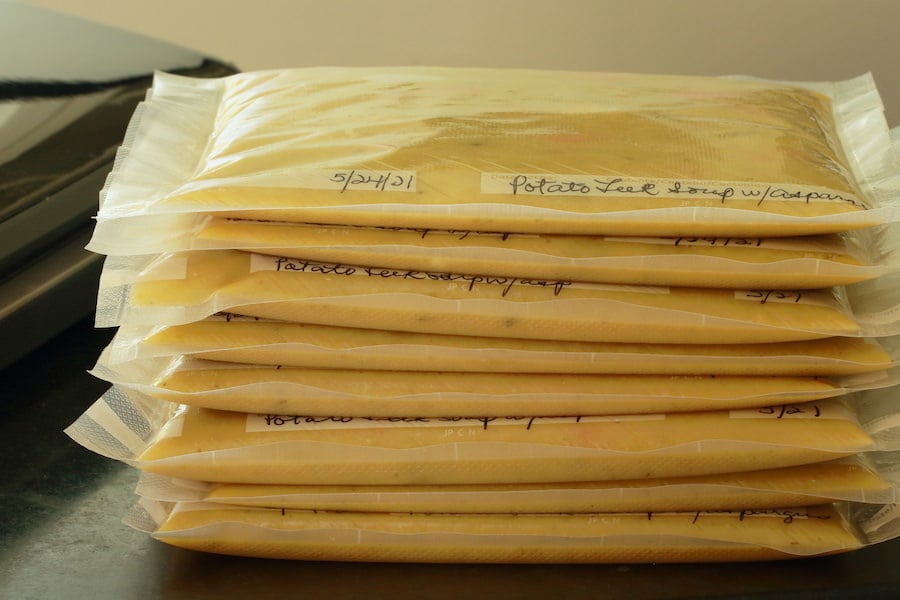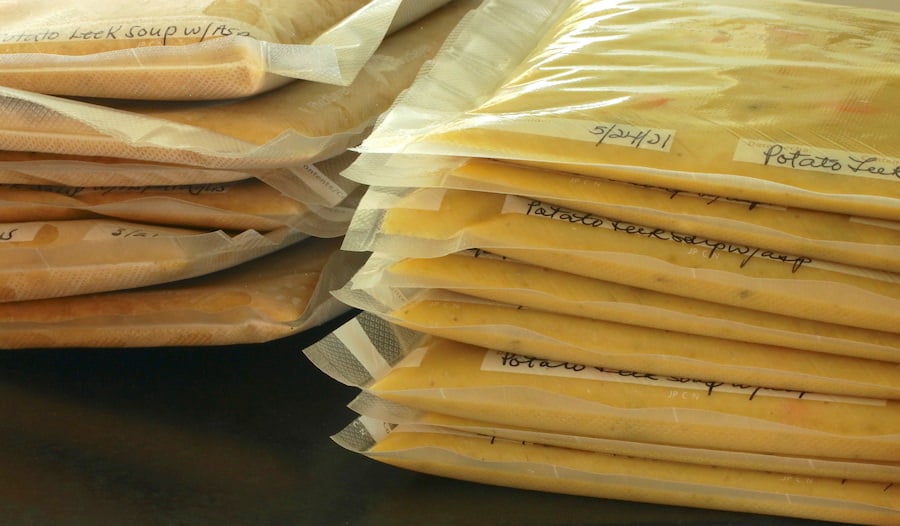The video below demonstrates how to vacuum seal liquids into flat packages using a basic vacuum sealer. I use a FoodSaver vacuum sealer; the rolls of plastic and bags are BPA free. I assume that other brands would work equally well.
Over the years I’ve used this technique when freezing soups, stews, sauces, tomato puree, and more. Because the liquids are frozen into flat packages, they stack nicely in the freezer and conserve space.
Some people suggest first freezing liquid into cubes, then vacuum sealing the cubes. I find that extra step to be completely unnecessary, and the resulting packages are bumpy and don’t stack as well. Freezing the liquid directly into flat packages is faster, easier, and more efficient.
I recently noticed that there are expensive vacuum sealers for sale made specifically for liquids. Again, I find my method works perfectly well without investing in a larger, more expensive machine.

Tips for Vacuum Sealing Liquids
- The edges of your packages may become wet if liquid is drawn out during the vacuum sealing process. Simply wipe with a dish cloth and then blot dry.
- Before freezing, be sure your packages are dry, otherwise they may stick together in the freezer. As an option, you can layer a paper towel between each package.
- The packages will stack better if they are all the same size.

If you like this tutorial on how to vacuum seal liquids, you may also enjoy another one I created, How to Make and Freeze Tomato Puree.


Thank you, Judy!
Patti R.
1
You’re very welcome!
Thank you!! Going to use my the Foodsaver for my RV fridge. Space is limited. Glad to know I will be able to freeze liquids in one step.
You’re so very welcome!
Thank you! Well explained!
Glad to be of help!
you’re a lifesaver Thank-you for sharing. i like to buy in bulk so much easier than canning and saves so much room
You’re welcome Lisa 🙂
I have a basic Ziploc vacuum sealer without the ‘Moist’ option. I added a little liquid with the food and it sucked out a lot of liquid so that it over flowed in the trough.
Hi Crystal,
Hummmm. Next time, try pressing “seal” if you notice liquid is being sucked out. Every so often that happens to me, and I press “seal” to stop any more from being drawn out.
I hope this helps,
Judy
I use my FOOD SAVER all the time. I usually put two seals at each end of the bag in case there is leakage. I do find that over time sone of the seals do leak air but contents is frozen so not an issue.
Hi Mary. I usually only seal each end once, and I don’t have problems with the seals breaking. I wonder if your machine isn’t working properly? Mine recently stopped working and I called FoodSaver. It was still under the 5 year warrantee so they sent me a new unit. The great part is that I didn’t need to find the receipt, and I hadn’t filled out a warrantee card. They could tell the manufacture date by the letters/numbers etched into one prong of the electrical plug.
I just purchased my very first Food Saver after wanting one for a long time. I am so happy to have found your tutorial on freezing liquids since that was one of the main reasons I bought it for. Your instructions were clear and easy to follow. Thank you.
Hi Deborah. Thanks for your kind words and welcome to the vacuum sealer club! Let me know if you have any questions.
its hard to see but sounds like you are not only sealing but vacuuming out the excess air correct? How does it not suck the liquid up and prevent the seal? I have a nutrichef and the liquid gets sucked up past the seal line and it doesn’t fully seal. it would be helpful to see the sealing and vacuuming by filming the video right above the sealer instead of from the side. Thank you
Hi David. Yes, after nudging out any trapped air bubbles, the air from the edge of the bag is sucked out before being sealed. Most of the time the machine starts sealing before any liquid is sucked out. Occasionally a bit of liquid is sucked out, but not enough to prevent a seal. Afterwards I just wipe the edge.
I love my food safer but my freeze dryer has been a life changer. You should look into one.
Hi Sandy,
I did a quick google search. Wow they’re expensive – about twice as expensive as my 10 tray Excalibur with stainless steel shelves.
Are you saying that you freeze dry sauces and soups?
a freeze dryer will run you about $2,500+ and yes it will preserve soups, sauces, and most other foods for 25 years without loosing nutrition like we see with other methods.
Hi Judy!,
I enjoyed this video and found it very useful. I appreciated your natural presence while doing this versus a performance video. I took a look at your recipes, Yummy! Will definitely be following you for more words of wisdom and delicious flavor profiles.
Be well,
Patty
Hi Patty,
Thanks so much and welcome!
Thank you- I am going to try it . I have the exact same model.
You’re welcome 🙂 Let us know how it goes!
How do you make sure liquid isn’t sucked out? I froze some food stuff that had a little liquid and it sucked it all out, the little tray overflowed.
Hi Donna. If it starts to suck out liquid, hit the seal button, and the machine will stop vacuuming and seal the bag.
What name of your vacuum device? I’d like to purchace the same for packing vegitable juices
Thank you in advance
Hi Sergey,
We have the base model FoodSaver and also the next step up from the base model.
I’m going to try refrigerating my bean soup rather than sealing it warm and then frigging/freezing. I found that I could use my machine but had to do the manual method (where you can control it) and that worked reasonably well. When I tried to just use the automatic method, it tried to suck ALL of the liquid out; it would not seal in time. Disaster. I’m going to try your canning jar/canning funnel method, too — beats measuring it in a liquid measuring cup and pouring it. Also, you’ve probably seen the method of folding over the top of the bag to prevent it from getting wet. Have you tried that? Thanks for your video.
Hi Becky,
Yes it’s always better to let soup cool down at least to room temperature before bagging/sealing/freezing. And refrigerating cooled down soup before bagging/sealing/freezing is even better. Yes, whenever I’m vacuum sealing, if the machine starts to suck the product into the machine I immediately hit seal, as you did.
I’m not sure I understand what you mean by folding over the top of the bag to prevent it from getting wet.
You’re welcome 🙂
Are you using 8 inch or 11 inch bags in your process?
Hi EJ,
I use 11-inch bags when packaging 1-quart of liquid.
The best video I have seen yet! I am a beginner to Food Saver and you explained things very simply. When opening the bag to heat the soup, do you take it out of the bag in the frozen state and heat it?.
Hi Susan – I’m glad to be of help!
I thaw the soup, or at least partially thaw it, so I can pour it into a pan.
If I’m in a time crunch, I soak the bag for a few minutes in warm water to expedite the thawing process.
I have the same model vacuum sealer. I’ve always had bad luck sealing any food that is moist. Always gets sucked up into the tray and doesn’t always seal properly. Is it possible that I’m curing the bags to small? Any help much appreciated.
I guess that’s possible. Are you cutting them a lot smaller than what I use?
Also, if the machine starts to suck liquid, just hit the “seal” button.
So before sealing, the soup should be refrigerated and cooled completely before sealing?
Cooled or at least down to room temperature.
Judy
Many thanks for your experience, openness and taking the time.
I have used this approach more than 50 times on a liquid mix and it has worked really well.
Looking at some of the comments above I did put the bag on a slight slope and raised the machine an inch.. which helps the bubbles know where they should go toward the machine and the liquid stays lower in the bag.
Best
Henry
Hello Henry. Glad it’s working out for you and thanks for sharing.
Has anyone had any problems with the expansion of the liquids once they seal damaging the seal? I am going to seal some soup but don’t want it to expand and damage my seal. Not sure if it is even a concern.
Thanks in advance!
Hi Tia. That’s never happened to me. If you’re worried, seal twice.
Hi Judy,
I am looking forward to trying your method. I think I haven’t been cutting my bags big enough in the past, and that helped me ruin one food saver device. Now before I start using my new food saver device, I thought I would witness a couple tutorials yours being my first! Anyway, one of my concerns is not getting a bunch of stuff up around the top of the bag and I like how you have that method of using the jar both were measuring but also if you put your bag down over it, it’s not gonna get all messy . Hooray!
I’m glad to be of help! Let us know how it goes 🙂
I’m grateful for this information and comments by you and others. One thing that helps me in sealing anything is to put a book or two or stack of magazines under the bag so it will be level with the machine opening.
what model foodsaver do you use?
my sister makes a lot of soups and I would like to gift her this for her birthday. ty so much I love your vídeos
Hi Sharon,
It’s one of the base models.
thank you for this video. I have just bought a vacuum sealer on ebay and the thought occurred ‘can I freeze soup?’ and now I know I can. I make a lot of soup here in Scotland, especially in the winter. I like to freeze lunch sized portions and your way will create so much space in the freezer. thank you again. 👍
You’re very welcome! Yes, freezing packages flat for stacking does save space.